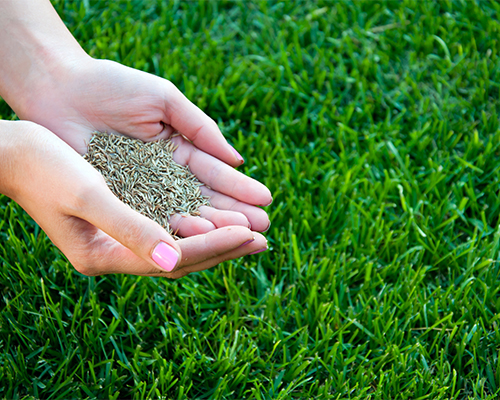Lawn Repair
“Green grass is happy grass.”
Julius Veal
Lawn Repair
Is your lawn in bad shape? If more than half of your lawn is infested with weeds or is brown and dead, then you might want to consider renovating it or putting in a new lawn from seed or sod. Late summer through early fall is the best time to renovate lawns. Plentiful rainfall, cooler temperatures and the lack of competition from weeds combine to make this the best time to accomplish seeding and sodding.


Seeding or Sodding Your Lawn?
Seeding
- Remove all dead and living grass, weeds, large stones and other debris from the area.
- Spread a generous amount of compost or peat moss, an organic fertilizer and lime (if needed) over the area.
- Work these materials into the soil to a depth of at least 6 to 8 inches. Rototilling works best; you can rent one from a local tool rental store.
- Level the soil and break up any large clumps. Use a roller to flatten high spots and help with the leveling while avoiding compacting the soil too much.
- Use a seed mixture that best suits the area’s conditions (sun, shade, etc.); we can help you select the right mixture.
- Lightly rake the seed into the surface of the soil or cover with premium topsoil.
- Gently water the area and check it daily. Keep the soil surface constantly moist for the next few weeks. Never let a newly seeded area dry out. It may be necessary to water twice a day during hot summer days.
- Fertilize with an organic fertilizer 6 to 8 weeks after the grass seed germinates.
Sodding
- Remove all dead and living grass, weeds, large stones and other debris from the area.
- Spread a generous amount of compost or peat moss, a starter fertilizer**and lime (if needed – see box for pH testing information) over the area.
- Work these materials into the soil to a depth of at least 6 to 8 inches. Rototilling works best; you can rent one from a local tool rental store.
- Level the soil and break up any large clumps. Use a roller to flatten high spots and help with the leveling.
- When area is level, lightly wet the soil with a fine mist of water.
- Lay down strips of sod in an alternating, brick-like pattern, making sure that the edges touch one another.
- Water the area well after laying the sod and continue to water daily or as needed until the sod roots grow into the soil. Pay close attention to keeping the seams wet. This should take 2 to 3 weeks.
- After the sod has rooted-in well, resume normal maintenance.
- Fertilize with an organic fertilizer 6 to 8 weeks after laying the sod to keep it green and vigorous.
Seeding Bare Spots
- Remove dead grass, weeds and other debris from the bare spot.
- Loosen the soil with a spade or garden fork and mix a generous amount of compost or peat moss, a good organic fertilizer and lime (if needed).
- Rake and level the spot.
- Use a seed mixture that best suits the area’s conditions (sun, shade, etc.); we can help you select the right mixture.
- Lightly rake the grass seed into the surface of the soil or cover with a premium topsoil.
- Gently water. Check for water daily to keep soil surface constantly moist for the next few weeks. Never let a newly seeded area dry out.
- Fertilize the entire lawn with an organic fertilizer 6 to 8 weeks after seed germinates.
Seeding a Thinned-Out Lawn
- Rake out and remove dead grass and weeds.
- Apply a good organic fertilizer and lime (if needed).
- In the thinned-out area only, sow a seed mixture that best suits the area’s conditions; we can help you select the right mixture.
- Top dress seeded area with a light covering (1/8”) of premium topsoil to help keep the seed moist and to hide it from the birds.
- Gently water. Check for water daily to keep soil surface constantly moist for the next few weeks. Never let a newly seeded area dry out.
- Fertilize the entire lawn with an organic fertilizer 6 to 8 weeks after seed germinates.
PH Testing
Lawns prefer a pH range of 6.2 to 6.8 (6.5 is optimum). Lime is used to raise the soil pH if it is below the desired range. Bring a half-cup of DRY soil to our Lawn & Garden Information Desk; we will gladly test your soil’s pH for FREE and the results are available while you wait. A proper pH is very important to a healthy lawn. Grass absorbs fertilizer and other minor elements best when the pH is correct. You will have a healthier lawn with fewer weeds and less fungus when the pH is correct. pH meters and kits are also available for sale for at-home, on-the-spot testing.
*To kill grass and weeds before renovation, apply a non-selective weed and grass killer 2–3 weeks before soil preparation and seeding or sodding. Roundup will not contaminate soil and will safely allow seed and sod to grow.
Download or print a PDF of Lawn Repair
TOOL
